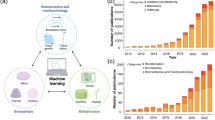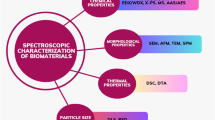Abstract
Developments and applications of bioceramics are reviewed. Used initially as alternatives to metallic materials in order to increase the biocompatibility of implants, bioceramics have become a diverse class of biomaterials presently including three basic types: bioinert high-strength ceramics; bioactive ceramics which form direct chemical bonds with bone or even with the soft tissue of a living organism; various bioresorbable ceramics which are actively included in the metabolic processes of an organism with predictable results. Certain members of the different types of bioceramics are the most bioinert and biocompatible of all known biomaterials. A review of the composition, physicochemical properties, and biological behavior of the principal types of bioceramic materials is given, based on the literature and some of our own data. The materials include, in addition to classical sintered ceramics, bioglass-ceramics and bioglasses which are similar in composition, properties, and applications. Special attention is given to structure as the main physical parameter determining not only the properties of the ceramic materials, but also their reaction with the biomedium. The present status of research and development in bioceramics is characterized as a first step in the solution of complex problems at the confluence of materials science, biology, and medicine by the synthesis of “smart materials.”
Similar content being viewed by others
REFERENCES
L. L. Hench, “Bioceramics,” Amer. Ceram. Soc, 81, No. 7, 1705-1727 (1998).
S. F. Hulbert, J. C. Bokros, L. L. Hench, et al., “Ceramics in clinical applications: past, present and future,” in: High Tech Ceramics, P. Vincenzini (ed.), Elsevier, Amsterdam (1987), pp. 189-213.
L. L. Hench and J. Wilson, An Introduction to Ceramics, World Scientific, London (1993).
P. Christel, A. Meunier, et al., “Biomechanical compatibility and design of ceramic implants for orthopaedic surgery in bioceramics,” in: Material Characteristics Versus in vivo Behavior, P. Ducheyne and J. Lemons (eds.), Annals of New York Academy of Science (1988), 523.
L. L. Hench, R. J. Splinter, et al., “Bonding mechanisms at the interface of ceramic prosthetic materials,” J. Biomed. Mater. Res., 2, No. 1, 117-141 (1971).
M. T. M. Manley, “Calcium phosphate biomaterials,” in: Hydroxyapatite Coatings in Orthopedic Surgery: Review of the Literature, R. G. T. Geesink and M. T. Manley (eds.), Raven Press Ltd., N.Y. (1993), pp. 1-23.
M. I. Kabanova, V. A. Dybok, and V. V. Skorokhod, “Phase changes in powders based on zirconium dioxide when dissolved in fluoric acid,” Dokl. Akad. Nauk. USSR, Ser. B, No. 6, 39-43 (1989).
J. Black, “Ceramics and Composites,” in: Orthopedic Biomaterials in Research and Practice, Churchill Livingston, Inc., N.Y. (1988), pp. 191-211.
J. P. Werner, C. Lathe, et al., “Pore-graded hydroxyapatite materials for implantation,” in: British Ceramic Proceedings, The Sixth Conference and Exhibition of the European Ceramic Society, 2, No. 60 (1999), pp. 509-510.
A. A. Korzh, G. Kh. Gruntovskii, and S. V. Malyshkina, “Our experience and perspective on the use of ceramic materials for bone plastic,” Ortopediya, Travmatologiya, Protezirovaniya, No. 3, 35-37 (1887).
M. Jarcho, “Calcium phosphate ceramics as hard tissue prosthetics,” Clinical Orthopedics and Related Research, June, 1981, pp. 259-278.
L. L. Hench and J. K. West, “Biological application of bioactive glasses,” Life Chem. Rep., 13, 187-241 (1996).
S. D. Cook, K. A. Thomas, J. F. Kay, and M. Jarcho, “Hydroxyapatite-coated porous titanium for use in orthopedic implant applications,” Clinical Orthopedics and Related Research, May, 1998, pp. 303-312.
B. M. Tracy, S. D. Cook, J. F. Kay, et al., “Direct electron microscope studies of the bone-HA interface,” J. Biomed. Mater. Res., 18, 719-726 (1984).
C. A. Van Blitterswijk, J. J. Grote, W. Kuypers, et al., “Bioreactions at the tissue-hydroxyapatite interface,” Biomaterials, 6, July, 243-251 (1985).
H. P. Drobeck, S. S. Rothstein, K. I. Gumaer, et al., “Histological observations of soft tissue responses to implanted multifaceted particles and disks of HA,” J. Oral Maxillofacial Surgery, 42, 143-149 (1984).
M. Ogiso, H. Kuneda, et al., “TEM analysis of hydroxyapatite interfacial reactions,” J. Dent. Res., 1, 419-424 (1981).
T. Kokubo, “Surface chemistry of bioactive glass-ceramics,” J. Non-Cryst. Solids, 120, 138-151 (1990).
U. Gross, R. Kimme, et al., “The response of bone to surface active glass/glass-ceramics,” CRC Crit. Rev. Biocompat., 4, 2 (1988).
U. Gross and V. Strunz, “The interface of various glasses and glass3/4ceramics with a bone implantation bed,” J. Biomed. Mater. Res., 19, 251 (1985).
U. Gross, J. Brandes, et al., “The ultrastructure of the interface between a glass-ceramics and bone,” J. Biomed. Mater. Res., 15, 291 (1981).
T. Yamamuto, L. L. Hench, and J. Wilson (eds.), Bioactive Glasses and Glass-Ceramics: Handbook on Bioactive Ceramics, Vol. 1, CRC Press, Boca Raton, Florida (1990).
T. Yamamuto, L. L. Hench, and J. Wilson (eds.), Calcium Phosphate and Hydroxyapatite Ceramics: Handbook on Bioactive Ceramics, Vol. 2, CRC Press, Boca Raton, Florida (1990).
J. Huang, L. DiSilvo, et al., “In vivo mechanical and biological assessment of hydroxyapatite reinforced polyethylene composite,” J. Mater. Sci. Mater. Med., 8, 775-779 (1997).
M. T. M. Manley, “Calcium phosphate biomaterials: review of the literature,” in: Hydroxyapatite Coatings in Orthopedic Surgery, R. G. T. Geesink and M. T. Manley (eds.), Raven Press Ltd., N. Y. (1993), pp. 1-23.
TU 46.15.246-97. “Animal bone meal feed,” Publ. 1997.
A. Ravaglioli, A. Krajewski, M. Dandy, et al., “Chemical properties of various hydroxyapatite powders and industrial production,” Int. Ceram., 2, 80-85 (1994).
R. Z. LeGerous and J. P. LeGerous, “Calcium phosphate biomaterials: preparation, properties, and biodegradation,” in: Encyclopedic Handbook of Biomaterials and Bioengineering, Part A, Vol. 2 (1995), pp. 1429-1463.
S. D. Cook, K. A. Thomas, J. F. Kay, and M. Jarcho, “Hydroxyapatite-coated porous titanium for use in orthopedic implant applications,” Clinical Orthopedics and Related Research, May, 1998, pp. 313-312.
S. S. Rothstein, D. Paris, et al., “Use of durapatite for the rehabilitation of resorbed alveolar ridges,” J. Amer. Dental Association, 109, October, 571-574 (1984).
J. Wilson and S. B. Low, “Bioactive ceramics for periodontal treatment: comparative studies in the patus monkey,” J. Appl. Biomaterials, 3, 123-169 (1984).
G. Daculsi, R. Z. LeGeros, et al., “Transformation of biphasic calcium phosphate ceramics in vivo: ultrastructural and physicochemical characterisation,” J. Biomed. Mater. Res., 23, 883-894 (1989).
H. P. Drobeck, S. S. Rothstein, K. I. Gumaer, et al., “Histological observation of soft tissue responses to implanted, multifaceted particles and discs of HA,” J. Oral Maxillofacial Surgery, 42, 143-149 (1984).
P. S. Eggli, W. Muller, and R. K. Schenk, “Porous hydroxyapatite and tricalcium phosphate cylinders with two different pore size ranges implanted in the cancellous bone of rabbits. A comparative histomorphometric and histological study of bone ingrowth and implant substitution,” Clinical Orthopedics and Related Research, July, 1988, pp. 127-138.
C. P. A. T. Klein, A. A. Driessen, K. deGroot, and A. Van den Hooff, “Biodegradation behavior of various calcium phosphate materials in bone tissue,” J. Biomed. Mater. Research, 17, 769-784 (1983).
R. Bell and O. R. Beirne, “Effect of HA, tricalcium phosphate, and collagen on the healing of defects in the rat mandible,” J. Oral Maxillofacial Surgery, 46, 589-594 (1988).
C. A. Van Blitterswijk, J. J. Grote, W. Kuypers, et al., “Bioreaction at the tissue/hydroxyapatite interface,” Biomaterials, 6, July, 243-251 (1985).
H. P. Drobeck, S. S. Rothstein, K. I. Gumaer, et al., “Histological observation of soft tissue responses to inplanted multifaceted particles and discs of HA,” J. Oral Maxillofacial Surgery, 42, 143-149 (1984).
H. A. Hoogendoorn, W. Renooij, L. M. A. Akkermans, et al., “Long-term study of large ceramic implants (porous hydroxyapatite) in dog femora,” Clinical Orthopedics and Related Research, July/August, 281-288 (1984).
K. I. Gumaer, A. D. Sherer, R. G. Slighter, et al., “Tissue response in dogs to dense HA implantation in the femur,” J. Oral Maxillofacial Surgery, 44, 618-627 (1986).
S. D. Cook, M. C. Reynolds, et al., “Evaluation of HA graft materials in canine cervical spine fusions,” Spine, 11, No. 4, 305-309 (1986).
P. A. Dieppe, E. C. Huskisson, et al., “Apatite deposition disease. A new arthropathy,” Lancet, 7954, February 7, 266-269 (1976).
M. Nagase, D. G. Baker, and H. R. Schumacher, “Prolonged inflammatory reactions induced by artificial ceramics in the rat pouch model,” J. Rheumatology, 15, No. 9, 1334-1338 (1988).
P. E. Cullum, D. E. Frost, et al., “Evaluation of HA particles in the repair of alveolar clefts in dogs,” J. Oral Maxillofacial Surgery, 46, 190-196 (1988).
T. Rooney, S. Berman, A. T. Indersano, “Evaluation of porous block HA for augmentation of alveolar ridges,” J. Oral Maxillofacial Surgery, 46, 15-18 (1988).
J. W. Framme, P. G. J. Rout, et al., “Ridge augmentation using solid and porous hydroxyapatite with and without autogenous bone or plaster,” J. Oral Maxillofacial Surgery, 45, 771-777 (1987).
H. V. Dennissen, H. J. A. Van Dijk, K. DeGroot, et al., “Biological and mechanical evaluation of dense calcium hydroxyapatite made by continuous hot pressing,” in: Mechanical Properties of Biomaterials, G. W. Hastings and F. Williams (eds.), J. Wiley & Sons, N.Y. (1980), pp. 489-505.
C. P. A. T. Klein, A. A. Driessen, K. DeGroot, and A. Van den Hoff, “Biodegradation behavior of various calcium phosphate materials in bone tissue,” J. Biomed. Mater. Res., 17, 769-784 (1983).
C. A. Van Blitterswijk, J. J. Grote, et al., “The biological performance of calcium phosphate ceramics in an infected implantation site. II. Biological evaluation of hydroxyapatite during short term infection,” J. Biomed. Mater. Res., 20, 1003-1015 (1986).
K. DeGroot, Bioceramics of Calcium Phosphate, CRC Press, Boca Raton, Florida (1983).
R. E. Holmes, R. W. Wardrop, et al., “HA as a bone graft substitute in orthognatic surgery: histological and histometric findings,” J. Oral Maxillofacial Surgery, 46, 661-671 (1988).
S. S. Rothstein, D. Paris, et al., “Use of durapatite for the rehabilitation of resorbed alveolar ridges,” J. Amer. Dental Association, 109, October, 571-574 (1984).
J. N. Kent, J. H. Quinn, et al., “Correction of alveolar ridge deficiencies with non-resorbable HA,” J. Amer. Dental Association, 105, December, 993-1001 (1982).
J. N. Kent, J. H. Quinn, et al., J. Oral Maxillofacial Surgery, 41, 829-642 (1983).
M. S. Block and J. N. Kent, “Long-term radiographic evaluation of HA-augmented mandibular alveolar ridges,” J. Oral Maxillofacial Surgery, 42, 793-796 (1984).
A. N. Cranin and N. M. Satler, “Human mandibularalveolar ridge augmentation with HA: final report of a five-year investigation,” in: 10th Annual Meeting of the Society for Biomaterials (Washington, April 27-May 4, 1984), p. 324.
J. W. Frame, “Hydroxyapatite as a biomaterial for alveolar ridge augmentation,” Int. J. Oral Maxillofacial Surgery, 16, 642-655 (1987).
F. M. Zide, J. N. Kent, et al., “HA cranioplasty directly over dura,” J. Oral Maxillofacial Surgery, 45, 481-486 (1987).
V. A. Dubok, E. O. Zhurakivskii, L. A. Ivanchenko, et al., “On defects in the crystal structure of hydroxyapatite microcrystals,” Metallofizika i Noveishie Tekhnologii, 19, 31-37 (1997).
V. A. Dubok, L. A. Ivanchenko, and N. V. Ul'yanchich, “Synthesis and properties of non-stoichiometric hydroxyapatite,” Metallofizika i Noveishie Tekhnologii, 19, No. 3, 102-106 (1997).
V. A. Dubok and N. V. Ul'yanchich, “Synthesis, properties, and application of osteotropic substitutes for bone tissue based on hydroxyapatite ceramics,” Ortopediya, Travmatologiya i Protezirovanie, No. 3, 26-30 (1998).
V. A. Dubok, N. V. Ul'yanchich, B. A. Tolstopyatov, and V. V. Protsenko, “Control of the properties of synthetic hydroxyapatite ceramics for various implants in orthopedia and traumatology,” in: Problems, Accomplishments and Future Developments in Medico-Biological Sciences and Public Health Care [in Russian], Tr. Krym. Gos. Med. Unta, 135, Ch. 2, 129-132 (1999).
T. W. Bauer, R. G. T. Geesink, et al., “Hydroxyapatite-coated femoral stems. Histological analysis of component retrieved at autopsy,” J. Bone Joint Surgery, 73A, No. 10, 1439-1452 (1991).
Author information
Authors and Affiliations
Rights and permissions
About this article
Cite this article
Dubok, V.A. Bioceramics ― Yesterday, Today, Tomorrow. Powder Metallurgy and Metal Ceramics 39, 381–394 (2000). https://doi.org/10.1023/A:1026617607548
Issue Date:
DOI: https://doi.org/10.1023/A:1026617607548




